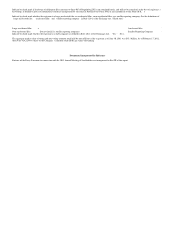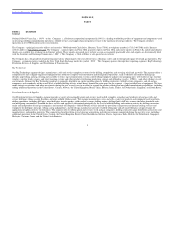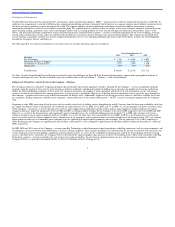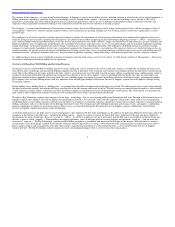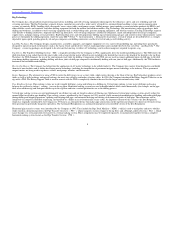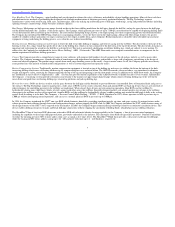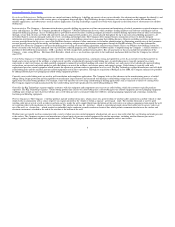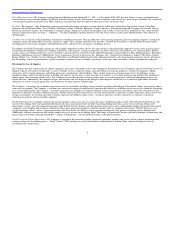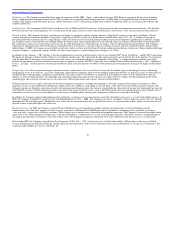National Oilwell Varco 2012 Annual Report Download - page 8
Download and view the complete annual report
Please find page 8 of the 2012 National Oilwell Varco annual report below. You can navigate through the pages in the report by either clicking on the pages listed below, or by using the keyword search tool below to find specific information within the annual report.
Index to Financial Statements
Pipe Handling Tools. The Companys pipe handling tools are designed to enhance the safety, efficiency and reliability of pipe handling operations. Many of these tools have
provided innovative methods of performing the designated task through mechanization of functions previously performed manually. The Rig Technology segment
manufactures various tools used to grip, hold, raise, and lower pipe, and in the making up and breaking out of drill pipe, workstrings, casing and production tubulars including
spinning wrenches, manual tongs, torque wrenches and kelly spinners.
Mud Pumps. Mud pumps are high pressure pumps located on the rig that force drilling mud down the drill pipe, through the drill bit, and up the space between the drill pipe
and the drilled formation (the annulus) back to the surface. These pumps, which generate pressures of up to 7,500 psi, must therefore be capable of displacing drilling fluids
several thousand feet down and back up the well bore. The conventional mud pump design, known as the triplex pump, uses three reciprocating pistons oriented horizontally.
The Company has introduced the HEX Pump, which uses six pumping cylinders, versus the three used in the triplex pump. Along with other design features, the greater
number of cylinders reduces pulsations (or surges) and increases the output available from a given footprint. Reduced pulsation is desirable where downhole measurement
equipment is being used during the drilling process, as is often the case in directional drilling.
Hoisting Systems. Hoisting systems are used to raise or lower the drill stem while drilling or tripping, and to lower casing into the wellbore. The drawworks is the heart of the
hoisting system. It is a large winch that spools off or takes in the drilling line, which is in turn connected to the drill stem at the top of the derrick. The drawworks also plays an
important role in keeping the weight on the drill bit at a desired level. This task is particularly challenging on offshore drilling rigs, which are subject to wave motion. To
address this, the Company has introduced the Active Heave Drilling (AHD) Drawworks. The AHD Drawworks uses computer-controlled motors to compensate for the
motion experienced in offshore drilling operations.
Cranes. The Company provides a comprehensive range of crane solutions, with purpose-built products for all segments of the oil and gas industry as well as many other
markets. The Company encompasses a broad collection of brand names with international recognition, and includes a large staff of engineers specializing in the design of
cranes and related equipment. The product range extends from small cargo-handling cranes to the worlds largest marine cranes. In all, the Company provides over twenty
crane product lines that include standard model configurations as well as custom-engineered and specialty cranes.
Motion Compensation Systems. Traditionally, motion compensation equipment is located on top of the drilling rig and serves to stabilize the bit on the bottom of the hole,
increasing drilling effectiveness of floating offshore rigs by compensating for wave and wind action. The AHD Drawworks, discussed above, was introduced to eliminate
weight and improve safety, removing the compensator from the top of the rig and integrating it into the drawworks system. In addition to the AHD Drawworks, the Company
has introduced an Active Heave Compensation (AHC) System that goes beyond the capabilities of the AHD Drawworks to handle the most severe weather. Additionally,
the Companys tensioning systems provide continuous axial tension to the marine riser pipe (larger diameter pipe which connects floating drilling rigs to the well on the
ocean floor) and guide lines on floating drilling rigs, tension leg platforms and jack-up drilling rigs.
Blowout Preventers. BOPs are devices used to seal the space between the drill pipe and the borehole to prevent blowouts (uncontrolled flows of formation fluids and gases to
the surface). The Rig Technology segment manufactures a wide array of BOPs used in various situations. Ram and annular BOPs are back-up devices that are activated only if
other techniques for controlling pressure in the wellbore are inadequate. When closed, these devices prevent normal rig operations. Ram BOPs seal the wellbore by
hydraulically closing rams (thick heavy blocks of steel) against each other across the wellbore. Specially designed packers seal around specific sizes of pipe in the wellbore,
shear pipe in the wellbore or close off an open hole. Annular BOPs seal the wellbore by hydraulically closing a rubber packing unit around the drill pipe or kelly or by sealing
against itself if nothing is in the hole. The Companys Pressure Control While Drilling (PCWD) ® BOP, introduced in 1995, allows operators to drill at pressures up to
2,000 psi without interrupting normal operations, and can act as a normal spherical BOP at pressures up to 5,000 psi.
In 1998, the Company introduced the NXT® ram type BOP which eliminates door bolts, providing significant weight, rig-time, and space savings. Its unique features make
subsea operation more efficient through faster ram configuration changes without tripping the BOP stack. In 2004, the Company introduced the LXT, which features many of
the design elements of the NXT®, but is targeted at the land market. In 2005, the Company began commercializing technology related to a continuous circulation device. This
device enables drilling contractors to make and break drill pipe connections without stopping the circulation of drilling fluids, which helps increase drilling efficiency.
The ShearMaxTM line of low force BOP shear rams released in 2010 add substantial tubular shearing capability to the Companys line of pressure control equipment,
including the capability to shear large drill pipe tool joints, previously unheard of in the industry. This innovative shear blade design utilizes patented Puncture Technology
to reduce the shearing pressures 50% or more and in some cases as much as five times lower. The ShearMaxTM Blind shear provides a shear-and-seal design for drill pipe,
while the Casing and TJC shears address casing up to 16 OD and most tool joints up to 2 wall thickness, respectively.
7


